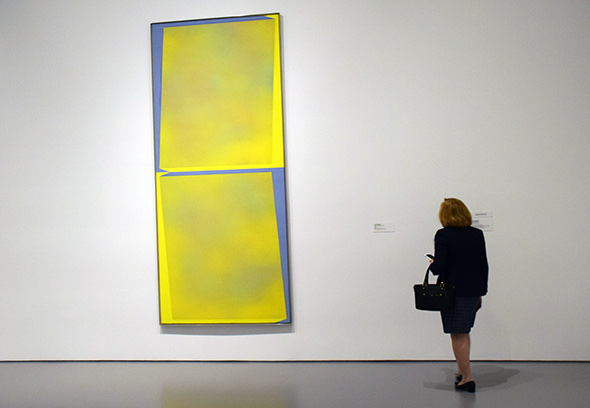Showing Rare or Never-Before-Seen Works
Collection Works Highlight Trends from Futurism to Arte Povera
“Le Onde: Waves of Italian Influence (1914–1971)” runs Aug. 22–Jan. 3, 2016, at the Smithsonian’s Hirshhorn Museum and Sculpture Garden. This exhibition of nearly 20 works from the museum’s collection follows Italian contributions to the transnational evolution of abstraction, through movements and tendencies such as futurism, spatialism, op art and kinetic art.
The exhibition includes several works that have been exhibited only rarely or not at all since entering the collection. Among those that have not been on view since the Hirshhorn’s inaugural exhibition in 1974–1975 are works by Zero group founder Heinz Mack, French op artist Yvaral and Italian painter Carlo Battaglia and several works by Italian artist Enrico Castellani.
“Joseph H. Hirshhorn was a visionary collector whose generosity made possible a museum of modern and contemporary art on the National Mall,” said Melissa Chiu, director of the museum. “This exhibition celebrates his legacy and underscores his commitment to Italian art.”
 “The Embassy of Italy in Washington is proud to be supporting this exhibition,” said Claudio Bisogniero, Italy’s ambassador to the United States. “For centuries, Italian artists have been cultural innovators whose ideas have reverberated around the world. ‘Le Onde’ sheds light on their contributions in the 20th century.”
“The Embassy of Italy in Washington is proud to be supporting this exhibition,” said Claudio Bisogniero, Italy’s ambassador to the United States. “For centuries, Italian artists have been cultural innovators whose ideas have reverberated around the world. ‘Le Onde’ sheds light on their contributions in the 20th century.”
A pivotal figure in the exhibition is Lucio Fontana, who was born in Argentina to Italian parents and divided his career between the two countries. “The pursuit of art forms that embraced the energy and ideas of a technological age was an international phenomenon, and Fontana was central to developments not only in Italy but throughout Europe and Latin America,” said Mika Yoshitake, an assistant curator at the museum, who co-organized the exhibition with Hirshhorn curator Kelly Gordon.
In addition, Fontana was an active teacher and theorist, the influence of his ideas also extending to artists on either side of the Atlantic, among them Brazilian sculptor Sérgio Camargo and Argentinian-born French artist Julio Le Parc, who studied under him in Buenos Aires. Fontana’s installations and writings helped inspire the Parisian collective GRAV (Groupe de Recherche d’Art Visuel/Group for Visual Art Research), whose members undertook experiments that often had scientific overtones, such as François Morellet’s “Wave Motion Thread” (1965), which manifests mechanical vibrations in the form of a standing wave.
 Fontana is best known for spatialist paintings in which the integrity of the picture plane is violated by slashes or holes. Three of these “Spatial Concepts” from 1967 are on view. These works inspired a generation of Italian artists that included Giò Pomodoro, whose towering fiberglass relief “Opposition” (1968) is marked with bulges and indentations, and Castellani, whose monochrome paintings have taut and pristine surfaces punctuated by nailheads.
Fontana is best known for spatialist paintings in which the integrity of the picture plane is violated by slashes or holes. Three of these “Spatial Concepts” from 1967 are on view. These works inspired a generation of Italian artists that included Giò Pomodoro, whose towering fiberglass relief “Opposition” (1968) is marked with bulges and indentations, and Castellani, whose monochrome paintings have taut and pristine surfaces punctuated by nailheads.
From the vantage point of the mid-century, the exhibition looks back to the work of Italian futurists such as Giacomo Balla, whose “Sculptural Construction of Noise and Speed” (1914–1915)/(reconstructed 1968) attempted to capture the dynamism of the machine age in material form. And it looks forward in time to the exploration of immateriality by artists associated with Arte Povera, such as Giovanni Anselmo, whose “Invisible” (1971) is a slide projection that shoots the Italian word “visibile” (visible, evident, apparent) into space, so that it comes into view only when a visitor steps in front of it and becomes the screen.
“Le Onde: Waves of Italian Influence (1914–1971)” is organized by the Hirshhorn Museum and Sculpture Garden, with support from the Embassy of Italy in Washington, D.C. The exhibition is accompanied by a catalog published by Gangemi that contains texts from Gordon, Yoshitake and Renato Miracco, cultural attaché for the embassy
